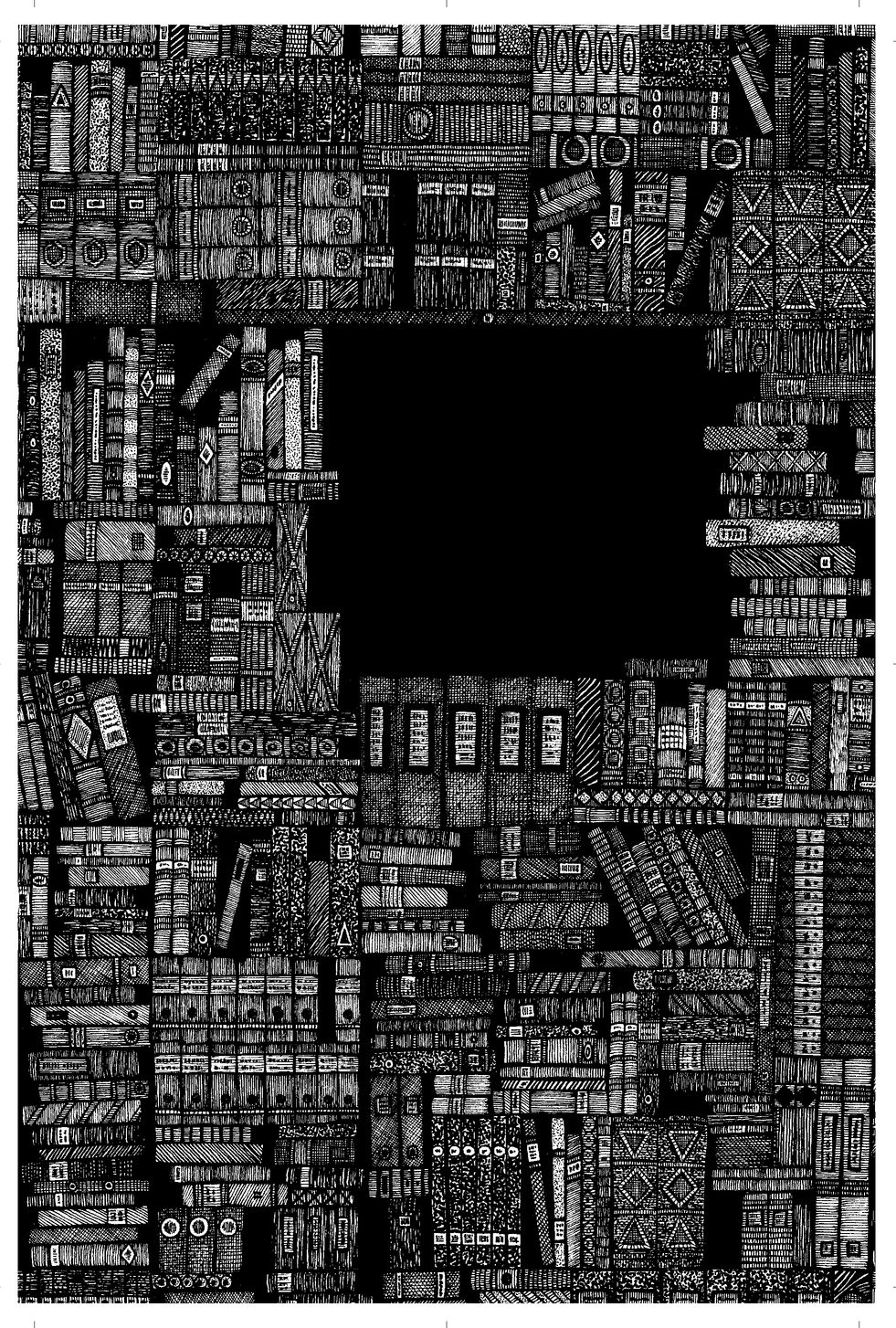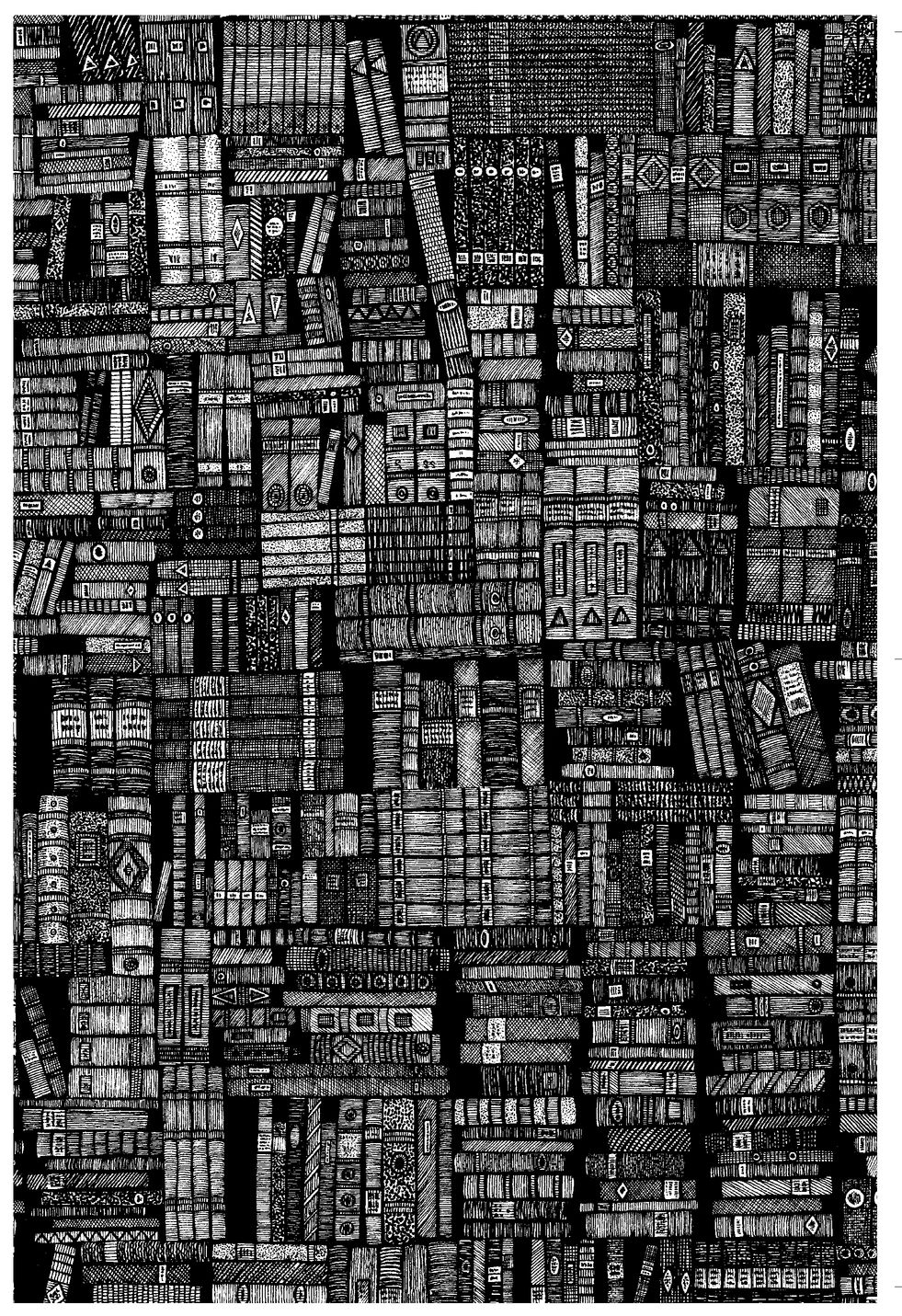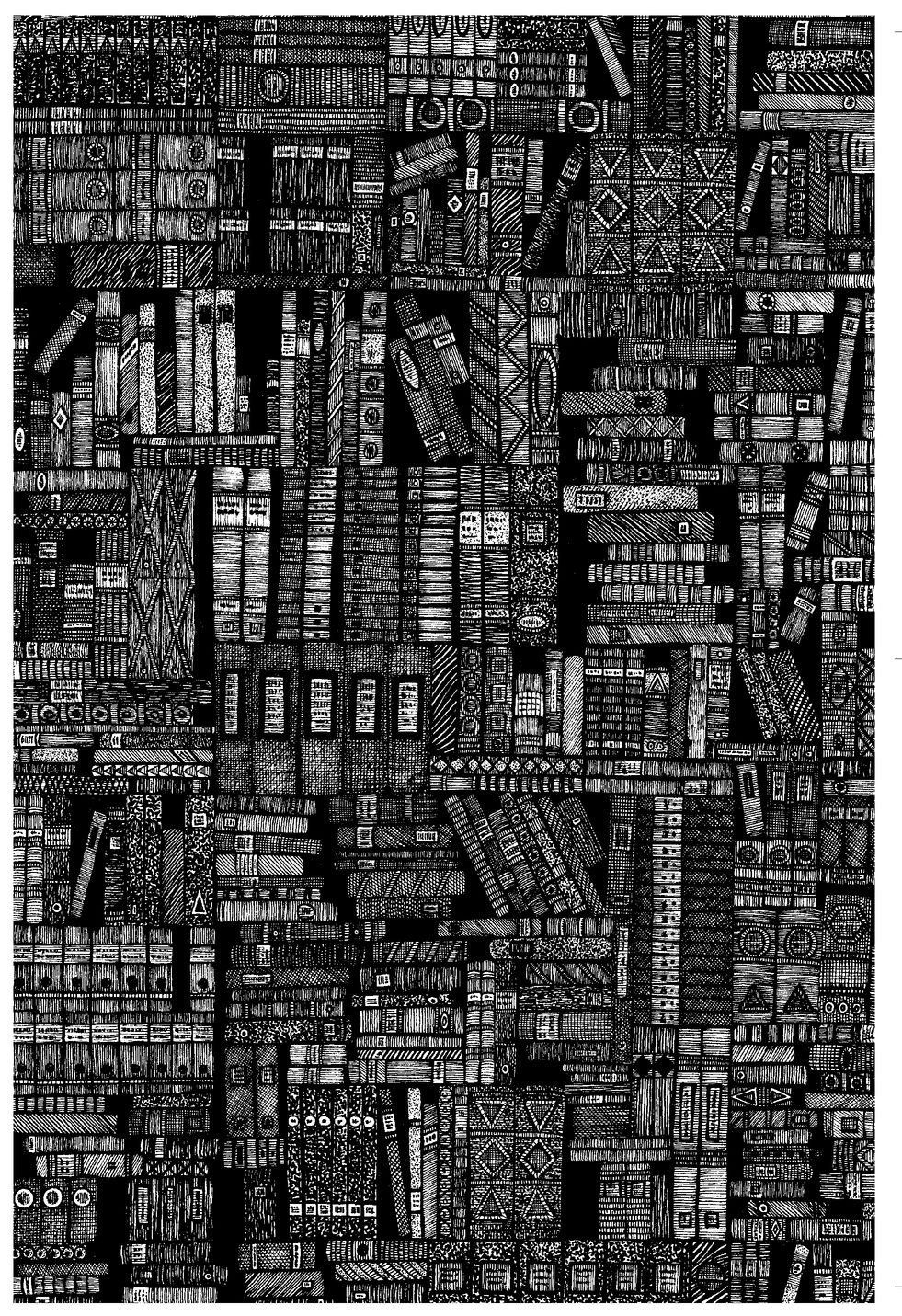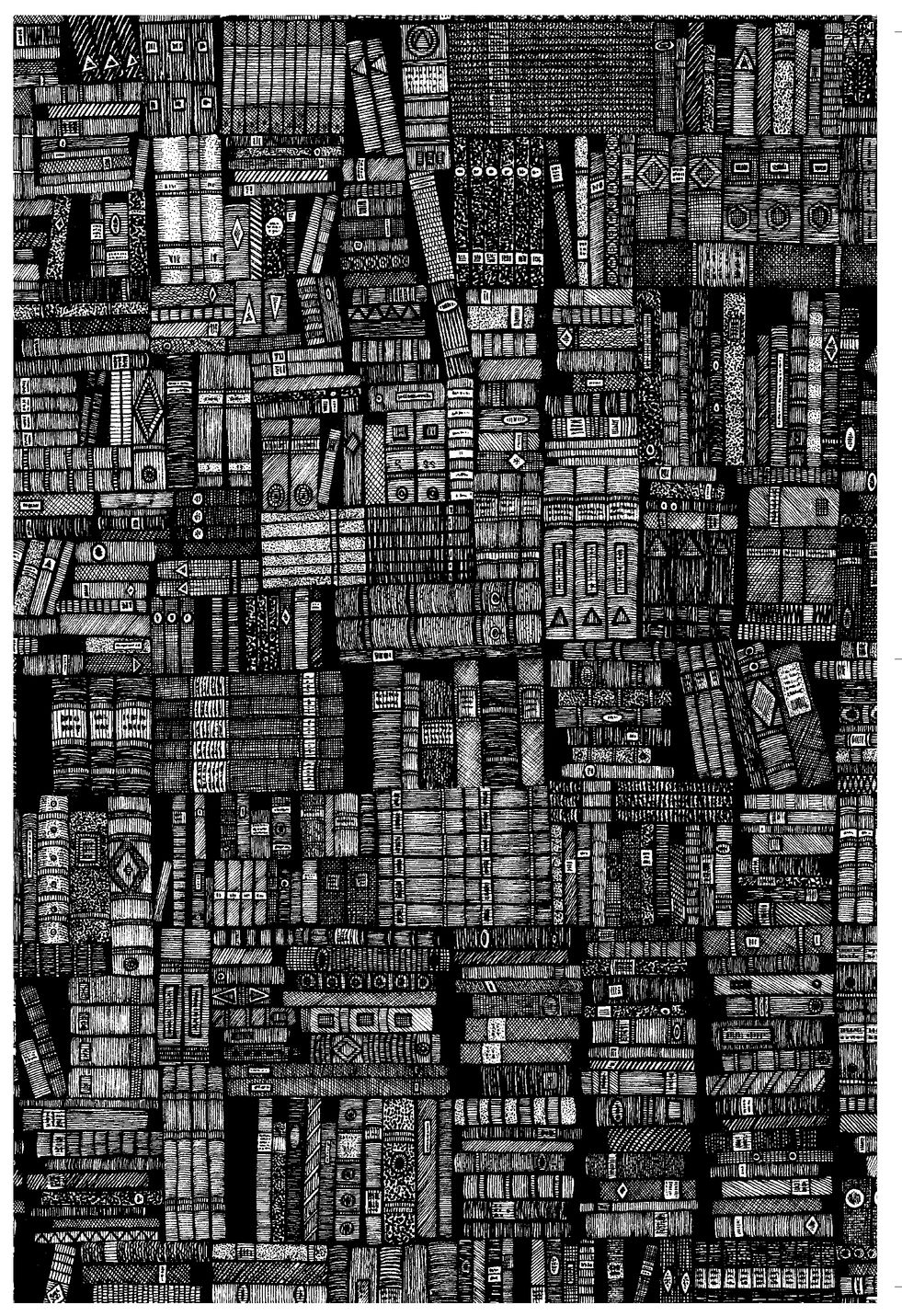The City of Dreaming Books (74 page)
Read The City of Dreaming Books Online
Authors: Walter Moers


For all kinds of reasons, I express my thanks to Erchl Gangwolff, Tito Milchvers and Danilie von Derwesch.
I am further indebted to Tito Milchvers for deciphering the symbols employed by Bookemistic numerologists.



1
Translator’s Note: Anyone fleetingly acquainted with Zamonian history or literature will know that Lindworm Castle is a hollowed-out rock projecting from the Dullsgard Plateau not far from Loch Loch in western Zamonia. The castle is inhabited by Lindworms that walk on their hind legs, are capable of speech and cherish a high regard for creative writing. As to how this came about, less well-informed readers should consult pp. 41-69 in
Rumo and His Miraculous Adventures.
They will not, however, find this essential to their further perusal of the present book.
Rumo and His Miraculous Adventures.
They will not, however, find this essential to their further perusal of the present book.
2
Translator’s Note: Zamonian exchange rates and units of measurement are such a complex subject that they merit a book of their own. This actually exists in the shape of the hundred-volume
Bunkle
, in which the druidical mathematician and economist Aristocious Bunkle meticulously listed and explained every one of Zamonia’s relevant systems. It is only natural, in a continent whose inhabitants range in size from peas to trees, that the most varied forms of currency and units of measurement exist. The Bonsai Mite’s
pyxl
is the Turniphead’s
forzz
, and if I were to translate both words as a metre I would be wrong each time, even though the Bonsai Mite and the Turniphead both mean a unit of measurement which, relative to their average physical size, corresponds to a metre. And I haven’t even mentioned the Hackonian
hakk
or the Voltigorkian
gork
! The inhabitants of Lindworm Castle - and, thus, Yarnspinner himself - employ an extremely complicated system of measurement that is strictly poetic in orientation, embodying units such as
hexameters
and
metaphorical density.
Bunkle
, in which the druidical mathematician and economist Aristocious Bunkle meticulously listed and explained every one of Zamonia’s relevant systems. It is only natural, in a continent whose inhabitants range in size from peas to trees, that the most varied forms of currency and units of measurement exist. The Bonsai Mite’s
pyxl
is the Turniphead’s
forzz
, and if I were to translate both words as a metre I would be wrong each time, even though the Bonsai Mite and the Turniphead both mean a unit of measurement which, relative to their average physical size, corresponds to a metre. And I haven’t even mentioned the Hackonian
hakk
or the Voltigorkian
gork
! The inhabitants of Lindworm Castle - and, thus, Yarnspinner himself - employ an extremely complicated system of measurement that is strictly poetic in orientation, embodying units such as
hexameters
and
metaphorical density.
There are races of Zamonian giants whose small change is as big as millstones, whereas life forms such as Nocturnomaths use a currency based on the telepathic exchange of doctoral dissertations. But, despite all these different conceptions of ‘money’, the pyra, a silver coin shaped like a tiny pyramid, is a universally recognised means of settling accounts, especially in commercial centres like Bookholm.
For descriptive purposes I have taken the liberty of translating Zamonian units of measurement into our own European units whenever Yarnspinner speaks of relative sizes, distances or weights. For authenticity’s sake, however, I have chosen not to translate the pyra, which roughly corresponds in value to one Roman sestertius in the time of Virgil.
3
Translator’s Note: My apologies, dear readers, but I can only guess at the meaning of the verb ‘glunk’. I devised the neologism myself as a translation of a Zamonian word I had never met before. Probably drawn from Lindworm Castle dialect, it almost certainly describes something which only Lindworms do with their teeth in order to produce a sound expressive of appreciation. I myself spent several days trying to make appreciative noises with my teeth, but to no avail.
4
Translator’s Note: Those who are unacquainted with Optimus Yarnspinner’s biography may be interested to know that this was a fateful encounter destined to have important repercussions on his subsequent career. Laptantidel Latuda, who was to become Yarnspinner’s arch enemy, persistently harried him with scathing reviews when he began to be published.
5
Translator’s Note: Among Zamonian scientists, Leyden Manikins are a favourite means of testing the effects of chemicals and medicaments without having to experiment on living life forms. A Leyden Manikin consists largely of peat from the Graveyard Marshes of Dullsgard with an admixture of Demerara Desert sand, adipose tissue, glycerine and liquid resin. These components are moulded into a manikin and animated with the aid of an alchemical battery.
If inserted in a glass receptacle and immersed in nutrient fluid, a Leyden Manikin will keep for about a month. It displays all the behavioural characteristics of a live creature, reacting to heat, cold and all manner of chemical compounds.
6
Translator’s Note: It may be helpful at this point if I give a brief description of the trombophone, an instrument with which Yarnspinner rightly assumed his Zamonian readers to be thoroughly conversant.
Trombophones are the only musical instruments capable of being bred. The trombophone shellfish, which derives its name from its distant resemblance to the trombone and euphonium, lives in coral reefs off the western shores of Zamonia, but especially in the vicinity of the city of Murkholm. It has an extremely long, tubular shell that develops into a convoluted knot, and it fills the depths of the sea, for as long as it survives there, with a ghostly kind of music not unlike the singing of whales.
Murkholmian beachcombers were the first to hit on the idea of using empty trombophone shells, which were regularly washed ashore on their coast, as musical instruments. Having fitted these with mouthpieces and valves, they developed in time into virtuosi who could coax the most delicate notes from their trombophone shells. Later they took to breeding trombophones and converting their shells into musical instruments for sale throughout Zamonia.
7
Translator’s Note: The Zamonian alphabet contains a letter symbolic of polypody, or many-leggedness. It occurs in the name of every life form that possesses more than eight legs. No such letter exists in our own alphabet, so I have had to resort to using the letter X four times, which in my opinion neatly symbolises sixteen-leggedness. This does not, however, mean that the X has to be enunciated four times over. Simply pronounce the word Spinxxxx as if it were spelt with one X only.
8
Translator’s Note: Gnomes can glunk their teeth like Lindworms, it seems, because I assume that Yarnspinner meant they were expressing approval. How he could tell they were doing so with their teeth when their mouths were hidden from his gaze, I do not know. Let us simply put it down to artistic licence.
9
Translator’s Note: Selwi Rollcar and Weddar Rale were founder members of a Dullsgardian school of poetry notorious for its deliberate cultivation of unintelligibility. To this end they larded their verse with bizarre neologisms designed to reduce their readers to a state of mental confusion as profound as the one from which they themselves suffered. The school broke up when Rollcar, muttering incomprehensible gibberish, was carted off to a lunatic asylum in Atlantis, there to end his days embroidering pocket handkerchiefs with endless repetitions of the same word,
Bandersnatch
, whose exact meaning has never been elucidated.
Bandersnatch
, whose exact meaning has never been elucidated.
10
Translator’s Note: Everyone in Zamonia has known what a Murch is since the publication of Gofid Letterkerl’s novel
Zanilla and the Murch
, so Yarnspinner dispenses with a description of that quaint little animal. Resident mainly in marshy areas, the Murch is a very rare creature best described as a cross between a duck and a frog. It gets its beak and downy plumage from the duck, its powerful hind legs and inflatable cheeks from the frog. The impressive sound a Murch can produce, known as ‘murching’, resembles the quacking of a duck and the croaking of a frog in equal measure.
Zanilla and the Murch
, so Yarnspinner dispenses with a description of that quaint little animal. Resident mainly in marshy areas, the Murch is a very rare creature best described as a cross between a duck and a frog. It gets its beak and downy plumage from the duck, its powerful hind legs and inflatable cheeks from the frog. The impressive sound a Murch can produce, known as ‘murching’, resembles the quacking of a duck and the croaking of a frog in equal measure.
11
Translator’s Note: Optimus Yarnspinner subsequently kept this undertaking in a work on the Booklings’ secret subterranean world.
Other books
Peekaboo Baby by Delores Fossen
An Unstill Life by Kate Larkindale
Doctor Who: The Rescue by Ian Marter
Jackson by Leigh Talbert Moore
1950 - Mallory by James Hadley Chase
A Longtime (and at one point Illegal) Crush by Janette Rallison
Edward Elgar and His World by Adams, Byron
Drácula by Bram Stoker
The Ghost of Grania O'Malley by Michael Morpurgo
How to Eat a Cupcake by Meg Donohue
